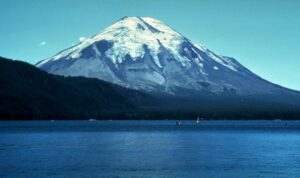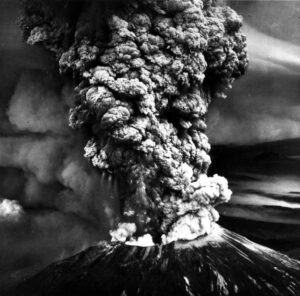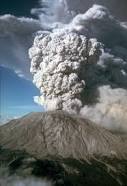Mount St. Helens, a perfect snow-white, cone-shaped mountain, was a favorite showpiece among Washingtonians for generations. A popular vacation spot, it boasted of beautiful lakes, challenging hiking trails, with rustic vacation homes and resorts nestled on the shores of pristine Spirit Lake. Photographers came from across the country to capture the elegant symmetrical cone of “America’s Fujiyama.”
Forty years ago today, on May 18, 1980, Mount St. Helens exploded in a violent eruption, following many earthquakes that spring. The blast blew off the top 1,300 feet of the mountain with five hundred times the force of the Hiroshima atomic blast. Within hours, the explosion destroyed 234 square miles of forest. Trees were either blasted away, snapped like pieces of straw, or scorched while standing, reducing one of the world’s most superb mountain landscapes to a gray wasteland.
Fifty-seven people lost their lives, though only about half those bodies were recovered. Most deaths were due to suffocation, others died from burns or as a result of falling objects. Of the lives lost, a few were scientists, but most fatalities were sightseers who had been repeatedly warned to stay clear of the area. An estimated 7,000 deer, elk and bear, and untold thousands of birds and small animals also perished. The Toutle River grew so hot witnesses reported seeing fish jump out of the water to escape the heat.
When Mount St. Helens first erupted, it sent a low-frequency shock wave straight up, which in turn reflected off several layers of the atmosphere and then bounced back to the ground in a large donut-shaped ring fifty to three hundred miles around the mountain. Thus, most people within fifty miles of the mountain did not hear the blast, yet it was heard as far away as Canada.
A menacing plume of ash boiled 60,000 feet into the atmosphere as the mountain turned itself inside out. The heavy ash cloud swept eastward across the continent in three days, and circled the globe in seventeen days. In Yakima, Washington, 138 miles from Mount St. Helens, emergency crews removed an estimated 600,000 tons of ash from the business district and residential areas. Ash flattened wheat fields and weighted down fruit trees. Agricultural losses in the Pacific Northwest totaled millions of dollars.
The blast and subsequent floods ruined or severely damaged more than three hundred homes, along with farm buildings and equipment. Hundreds of livestock were lost, either swept away in flood waters or buried in debris. Massive mudflows wiped out roads and bridges. For months afterward, extensive repair work was undertaken to regain use of the Columbia River and its tributaries.
Campers and loggers miles away from the blast zone heard an aftermath roar that one person described as sounding “like a couple of big passenger jetliners coming through the woods.” Within seconds, darkness covered the area and a terrific heat rolled in, burning people, animals and trees within its path.
My award-winning novel Tenderfoot is a work of fiction taking place during the months surrounding the Mount St. Helens eruption. Although the characters have been fictionalized, various experiences of blast victims represent true accounts.





